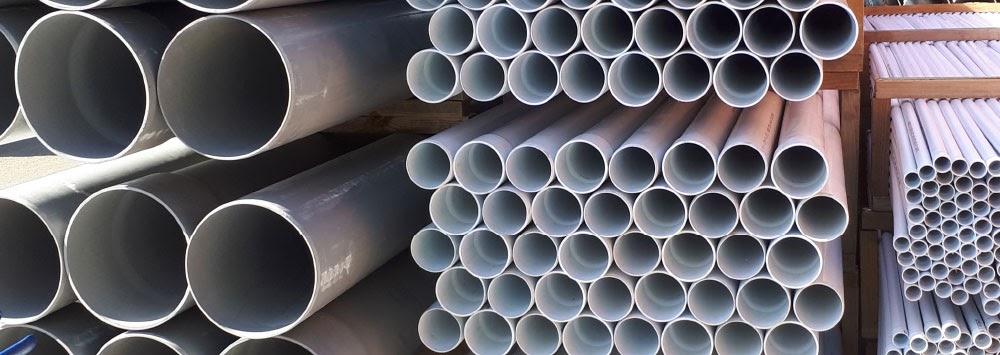5 design tips to extend the life of PVC pipework
PVC first began to be manufactured in the 1940’s used for Drain-Waste-Vent piping during the reconstruction of Germany and Japan following World War Two. Having been around for 80 years PVC has proven itself to be a reliable piping system. As with any piping system, understanding the limitations of the selected piping material and following key design principles can significantly improve the life expectancy of a piping system.

We will now explore five design tips which you can follow to ensure you get the most out of PVC pipework.
1. Understand temperature capability and pressure de-rating
PVC is suitable for an operating temperature of 4-40°C while able to withstand temperature spikes of up to 60°C. The minimum and maximum temperatures are not recommended for continuous operation or for applications of continuous fluctuations of these temperatures.
Specified pressure ratings for PVC pipe and fittings are based on a water application, non-shock, at 23°C. As the temperature of the liquid conveyed through the pipework increases, the pressure rating needs to be de-rated. This can simply be calculated by multiplying the specified pressure rating (in PSI) by the appropriate de-rating factor shown in the table below. For example, a 50mm PN12 (174PSI) pipe operating at 43°C would be de-rated to 88PSI (174 x 0.51 = 88.74PSI).

When working near the maximum specified temperature, solvent cement joints are recommended in the place of threaded connections. Where a disconnection point is required, look to use a reinforced threaded fitting, flanged connection, or union connection.
2. Minimise and where possible eliminate water hammer
The technical term for what we know as water hammer is ‘hydraulic shock’. This is the rapid increase in pressure due to a shock wave produced by a sudden change in the fluid velocity. If uncontrolled or pipe with insufficient pressure rating is used, these pressure surges can burst pipe and break fittings and valves. Hydraulic shock is frequently produced by rapid valve opening and closing, pumps starting and stopping, or even from a high-speed wall of water hitting a change of direction, such as an elbow.
Understanding the maximum surge in pressure relative to velocity changes is essential to estimating the pressure rating requirements of the pipe system. The following chart gives the maximum surge in pressure at velocities of 1, 5, and 10 metres per second for different pipe sizes based on instantaneous valve closure in a PVC system. While listed, 10 metres per second is not recommended and is shown for comparative purposes.
Schedule 40 Pipe Pressure Surge (PSI) at Different Velocities

Schedule 80 Pipe Pressure Surge (PSI) at Different Velocities

How can you minimise or eliminate hydraulic shock?
- Limit fluid velocity
- Control valve closing time – this can be done through pneumatic or electric actuators, or the use of gear operated valves.
- Control pump operation – operate the system to maintain uniform pump flow rates. VSD’s to control pump starting could be considered. Air chambers or surge relief tanks in conjunction with pressure regulating and surge relief valves can be used at pumping stations.
- Use check valves to maintain a full pipeline. However, be careful because some check valves operate on a flow reversal and can be rapid closing. Spring or lever assisted swing check valves can reduce hydraulic shock by avoiding ‘slamming’ the valve closed.
3. Be aware and allow for thermal expansion and contraction
Thermoplastic piping expands and contracts more than metallic piping when subjected to temperature changes. In fact, as much as 10 times that of steel. This particularly effects systems involving long runs, hot water lines, hot drain lines, and piping exposed to environmental temperature extremes.
The below table provides a guide on the possible change in length to PVC pipe in millimetres per metre. Thermal expansion and contraction can be compensated through appropriately sized expansion loops, offsets, bends, or expansion joints. This absorbs the stresses generated, minimising damage to the piping.

4. Protect the piping from UV radiation
For years it has been thought, u-PVC meant it was UV resistant PVC. Unfortunately, this is not the case and u-PVC is still subject to deterioration through UV impacts. You may ask what are the effects? Testing has shown UV can have the following effects on PVC:
- A colour change
- Slight increase in tensile strength
- Slight increase in modulus or tensile elasticity
- Slight decrease in impact strength
The testing also showed that the effects of UV exposure do not continue when exposure to UV is terminated. Also, the UV does not penetrate even thin shields such as paint coatings or wrapping.
To protect your PVC piping products, you could consider insulating the pipework, this would also help to reduce the effects of thermal expansion and contraction, or painting the pipework with a light-coloured acrylic or latex paint that is chemically compatible with PVC.
5. Protect PVC from freezing
Given PVC is relatively rigid compared to other thermoplastic materials, it is more susceptible to the impacts of liquid freezing in the pipeline. To overcome this, you could consider standard practises such as insulating the pipework, anti-freeze solutions, or heat trace tapes. However, with all these solutions it is important to clarify with your supplier compatibility between these products and PVC.
For underground pipework, thermoplastic pipe should ALWAYS be installed below the frost level according to local conditions. As a general rule, pipes conveying liquids susceptible to freezing should be buried no less than 300mm below the maximum frost level.
We trust you found this information of assistance, but should you have any further questions please do not hesitate to reach out to our team, we are here to help.





